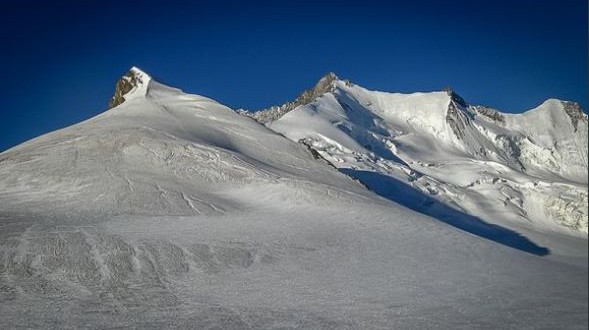The Stecknadelhorn is a small elevation on the Nadelgrat ridge, but because of its altitude of 4241 meters it is considered a 4000 meter peak in its own right. An ascent can be incorporated in a crossing of the Nadelgrat ridge, depending on climbers physical conditions. In the Pennine Alps, there are over 40 mountains that are higher than 4000 meters. The Stecknadelhorn is one of them, but a little one, only one elevation in the ridge of the Nadelgrat between Nadelhorn east and Hohberghorn west. It is not a goal for itself but hikers and mountaineers do the traverse of Stecknadelhorn on the famous Nadelgrat route. Or take Stecknadelhorn in addition after climbing Nadelhorn. The Stecknadelhorn is the most inconspicuous of the four summits above 4000 meters that make up the Nadelgrat ridge, in sequence the Nadelhorn, Stecknadelhorn, Hohbarghorn and Dirruhorn. The Stecknadelhorn stands immediately north-west of the Nadelhorn, and like the Hohbarghorn it is glaciated on its north side. The Nadelgrat lies some hidden, north-west of the Mischabel group. Its traverse is considered one of the most beautiful ridge climbs in the Alps. The Nadelgrat links the Lenzpitze, Nadelhorn, Stecknadelhorn, Hohbarghorn and Dirruhorn. The Stecknadelhorn has a very similar name to the neighboring Nadelhorn. Stecknadel means pin and Nadel translates as needle. The fact that the two summits also look very similar suggests that the name derives from the expression “looking for a needle in a haystack”. This etymology reflects the inconspicuousness and insignificance of this peak among the summits of the Nadelgrat ridge. The first on this mountain were Oskar Eckenstein and the famous mountaineer Matthias Zurbriggen, who was the first to climb Aconcagua, in the year 1887. They came from the Hohbergjoch and went back to Saas-Fee where they came from. The normal route is only a short trip from Nadelhorn that is the main goal for climbers. The route branches off from the normal north-east ridge to Nadelhorn just before reaching the summit rocks of Nadelhorn. There hikers and mountaineers have to turn right and traverse through the north flank of Nadelhorn. The traverse is steep and if snow is hard, it can be very dangerous. By this traverse hikers and mountaineers gain the very nice firm ridge of the south-east ridge of Stecknadelhorn. The ridge leads in some nice ups and downs, quite easy to the summit rocks, and is not difficult to climb. The best time of the year to summit this mountain is summer especially from July to September. At this time huts are guided and if there is few snows left from previous winter, hikers and mountaineers can try it in June as well.

